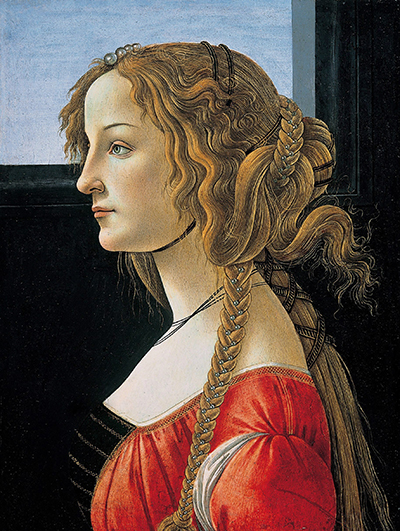Simonetta Vespucci would appear several times within the career of Sandro Botticelli, normally from a side profile portrait. She was considered the most beautiful woman in all of Florence at the time, and would have been courted by many artists looking to capture her image within their work.
Botticelli's most famous portrait of Simonetta was probably Portrait of a Young Woman, though the item found here was also technically impressive and a worthy addition to his oeuvre. Another portrait of her was simply titled Simonetta. When we consider the label given to this young woman as being the most attractive lady in all of Florence at the time, we can quickly understand how people of that era defined beauty by examining her own characteristics. Simonetta, as we can see here, was particularly pale in complexion with gentle, feminine features which one might expect from tastes of that time. She is dressed beautifully, but not overly glamorously, with a charming red dress which has a black pleated front. She has small touches of jewellery, always in a fairly subtle manner. Her hair is elaborate, however, with many twists and plats which the artist pays close attention to.
The artist chooses to keep the focus on this young woman by leaving out any real detail from the rest of the composition. There is a small window behind her which allows the artist to incorporate light and brighter colour, but the sky is delivered in a single tone of blue and the inside of the room is very dark. One's focus is therefore carefully directed straight at Simonetta Vespucci herself. Botticelli was undeniably a master portrait painter and would offer a delicate touch that most other male artists would struggle to achieve. Most of his paintings would be figurative, placing much more complex scenes together and those would therefore fail to illustrate the up-close details that he was able to achieve. Here we find just what he could achieve when producing the traditional shoulder-length portrait format which has been so common across a large number of different art movements.
Whilst Botticelli had enough subtlety within his skillset to produce stunning artworks with relatively little content, his finest paintings tended to be more complex undertakings. For example, the likes of The Birth of Venus, Primavera and Adoration of the Magi and rightly be considered amongst the most iconic of Renaissance images and even the most occasional art follower will probably be able to recognise them at first glance. He perhaps enjoyed the challenge of these larger undertakings and by employing a number of highly skilled assistants he would not have been concerned about the complexity of some of these projects. Over time Botticelli would be able to count on a large number of people within the establishment as potential patrons and he could work without the burden of financial concerns.




